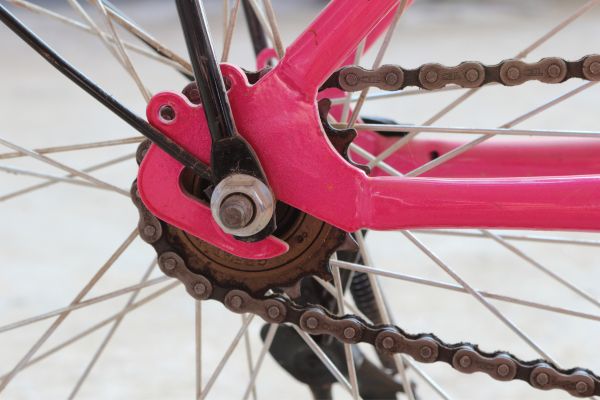If you’re new to the cycling world, you might be confused by all the technical jargon.
One term you’ll likely encounter is “chainstay,” a crucial bike component. I will discuss chainstays, their purpose, and why they matter in this article.
Without further ado, let’s learn what’s a chainstay.
What is a Chainstay?
A chainstay is part of a bicycle frame that connects the bottom bracket shell (where the crankset and pedals attach) to the rear dropouts (where the rear wheel is mounted).
The chainstay is located on the underside of the bicycle frame, running parallel to the chain. Chainstays can be made from various materials, including steel, aluminum, titanium, and carbon fiber.
Where is the Chainstay on a Bike?

The chainstay is located on the underside of the bike frame, running from the bottom bracket shell to the rear dropouts. If you flip the bike over, you can see the chainstay on the frame’s side facing the ground.
What is the Function of a Chainstay?
The primary function of the chainstay is to provide support and stiffness to the rear triangle of the bicycle frame.
When a rider applies power to the pedals, the chain transfers that power from the front chainring to the rear cassette, causing the rear wheel to turn.
The chainstay plays a key part in this process by ensuring that the rear triangle remains stable and doesn’t flex or twist under load.
Additionally, the chainstay helps absorb some of the road vibrations and impacts transmitted through the rear wheel, which helps to provide a smoother ride.
Chainstay Length by Different Bike Types
The length of the chainstay can vary depending on the type of bike. For example:
- Road bikes typically have shorter chainstays, usually between 405mm and 430mm. Shorter chainstays provide a more responsive ride and better acceleration.
- Mountain and cyclocross bikes usually have longer chainstays, typically between 420mm and 450mm. Longer chainstays provide more stability, making it easier to navigate rough terrain.
- Touring and commuter bikes can have longer chainstays, typically around 450mm to 480mm. Longer chainstays provide a more comfortable ride and space for panniers and cargo.
- Single-speed and fixed-gear bikes can have short chainstays, often around 380mm to 400mm. Short chainstays provide a more agile ride, which is important for track racing and urban riding.
In conclusion, the chainstay is a critical component of a bicycle frame, providing stability and support to the rear triangle.
The length of the chainstay can vary depending on the type of bike, with shorter chainstays providing a more responsive ride and longer chainstays providing more stability and comfort.
Long Chainstay vs Short Chainstay
Here’s a comparison between a long and short chainstay and their pros and cons.
Long Chainstay

Mountain, touring, hybrid, and commuter bikes have long chainstays. Here are some pros and cons of long chainstays:
Pros:
- Stability: Longer chainstays provide more stability to the rear triangle of the bike, which can be beneficial when riding on rough or uneven terrain.
- Comfort: Longer chainstays can help absorb some of the shock and vibration from the road or trail, providing a smoother and more comfortable ride.
- Cargo capacity: Longer chainstays provide more space for panniers and other cargo, making them a good choice for touring or commuting.
Cons:
- Less agile: Longer chainstays can make the bike feel less agile and responsive, which can be a disadvantage in tight corners or technical terrain.
- Slower acceleration: Longer chainstays can make accelerating harder, which can be a disadvantage in racing or fast-paced group rides.
Short Chainstay

Short chainstays are typically found on road and single-speed and track bikes. Here are some pros and cons of short chainstays:
Pros:
- Agile: Shorter chainstays provide a more agile and responsive ride, which can be beneficial in tight corners or technical terrain.
- Better acceleration: Shorter chainstays can make it easier to accelerate quickly, which can benefit racing or fast-paced group rides.
- More playful: Shorter chainstays can make the bike feel more playful and lively, which can benefit urban riding or stunts.
Cons:
- Less stable: Shorter chainstays provide less stability to the rear triangle of the bike, which can make the bike feel less stable on rough or uneven terrain.
- Less comfortable: Shorter chainstays can transmit more road or trail vibration to the rider, making the ride less comfortable.
- Less space for cargo: Shorter chainstays provide less space for panniers and other cargo, which can be a disadvantage for touring or commuting.
How to Measure Chainstay Length on Your Bike
Measuring the chainstay length on your bike is a relatively simple process that can be done with just a few tools. Here’s a step-by-step guide on how to measure chainstay length on your bike:
Prepare Your Bike
First, you’ll need to prepare your bike for measurement. Turn your bike upside down, resting on the handlebars and saddle. This will give you clear access to the chainstay.
Locate the Chainstay
Locate the chainstay on the underside of the bike frame, running from the bottom bracket shell to the rear dropout.
Measure the Chainstay

Measure the length of the chainstay using a tape measure or ruler.
Place the tape measure or ruler at the center of the bottom bracket shell, where the bottom bracket spindle is located.
Then measure along the chainstay length to the center of the rear dropout.
Record the Measurement
Once you have measured the chainstay, record the length in millimeters or inches, depending on your preference.
It’s worth noting that the chainstay length can vary slightly depending on how you measure it, so it’s a good idea to take a few measurements to ensure accuracy.
Also, suppose you have a suspension system on your bike. In that case, the chainstay length can change as the suspension compresses, so measuring the chainstay with the suspension in a neutral position is important.
In summary, measuring the chainstay length on your bike is a simple process that can be done with a tape measure or ruler. Just remember to take a few measurements to ensure accuracy and account for any suspension systems on your bike.
Does Chainstay Length Matter?
Yes, the chainstay length on the bike matters and can significantly impact the bike’s overall ride feel and performance.
The chainstay length can affect:
- bike stability,
- bike agility
- and bike acceleration.
Longer chainstays generally provide greater stability to the bike’s rear triangle, making it easier to ride on rough or uneven terrain.
They can also provide more space for cargo, which can be beneficial for touring or commuting. However, longer chainstays can make the bike feel less agile and responsive, which can be a disadvantage in tight corners or technical terrain.
They can also make it harder to accelerate quickly, which can be a disadvantage in racing or fast-paced group rides.

Shorter chainstays, on the other hand, provide a more agile and responsive ride, making it easier to navigate tight corners or technical terrain.
They can also accelerate quicker, benefiting racing or fast-paced group rides.
However, shorter chainstays can provide less stability to the bike’s rear triangle, making it feel less stable on rough or uneven terrain. They can also transmit more road or trail vibration to the rider, making the ride less comfortable.
Check out this video to see the effect of chainstay length in MTB
In summary, chainstay length does matter and can significantly impact the bike’s overall ride feel and performance.
The optimal chainstay length will depend on the type of riding you plan to do and your personal preferences.
It’s important to consider the terrain you’ll be riding on, your riding style, and any cargo you’ll carry when choosing the right chainstay length for your bike.
Conclusion
In conclusion, the chainstay is a critical component of a bicycle frame, providing stability and support to the rear triangle.
The length of the chainstay can vary depending on the type of bike, with shorter chainstays providing a more responsive ride and longer chainstays providing more stability and comfort.


